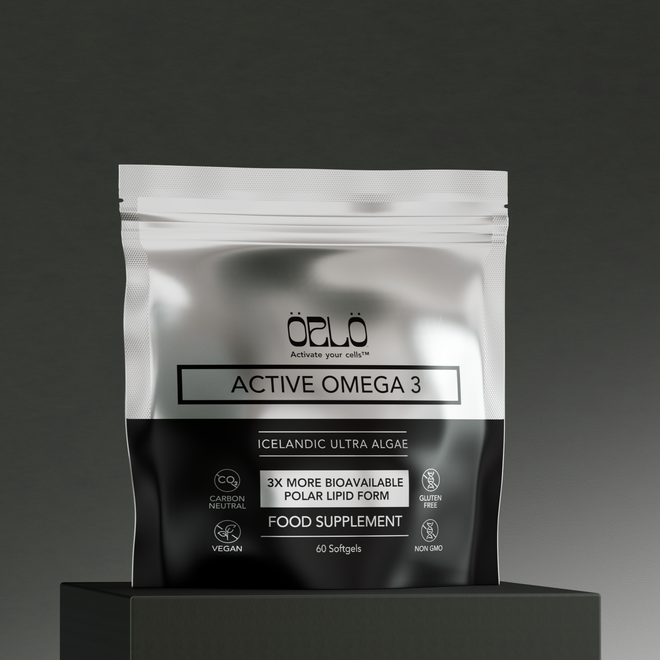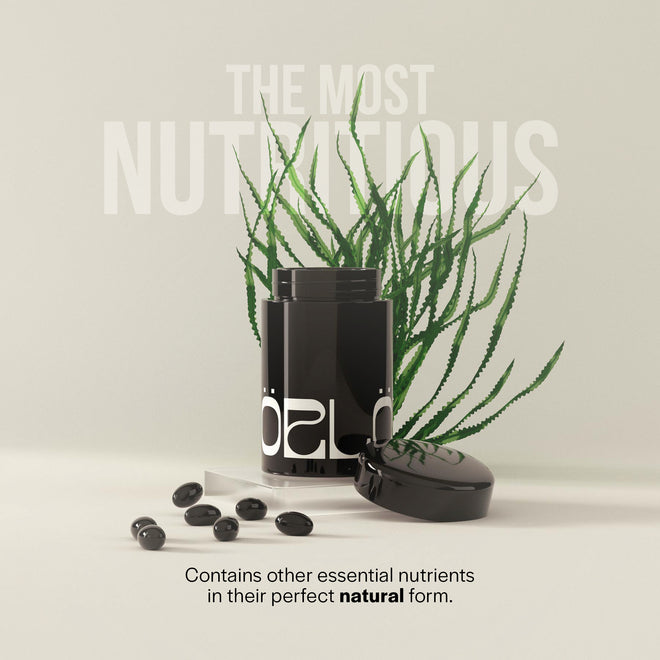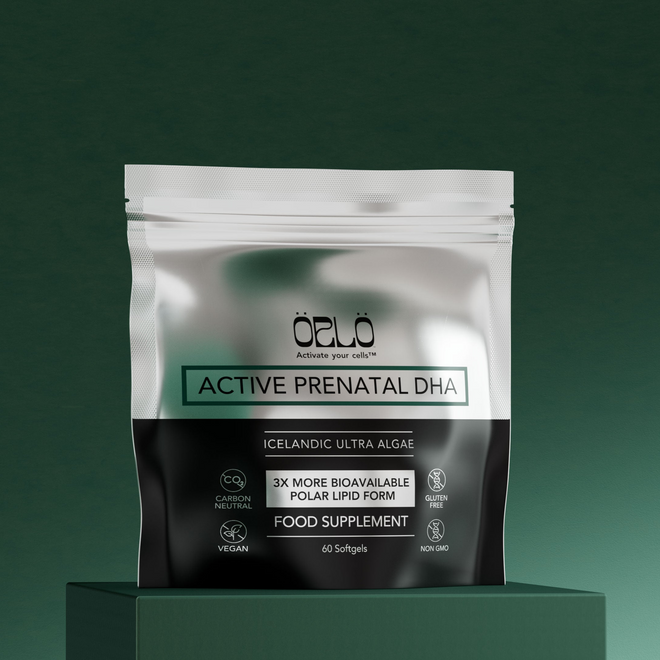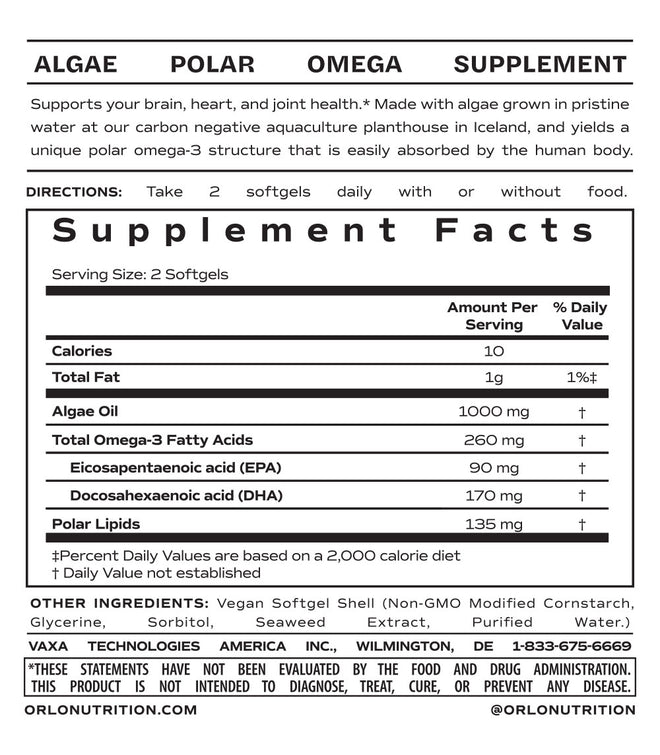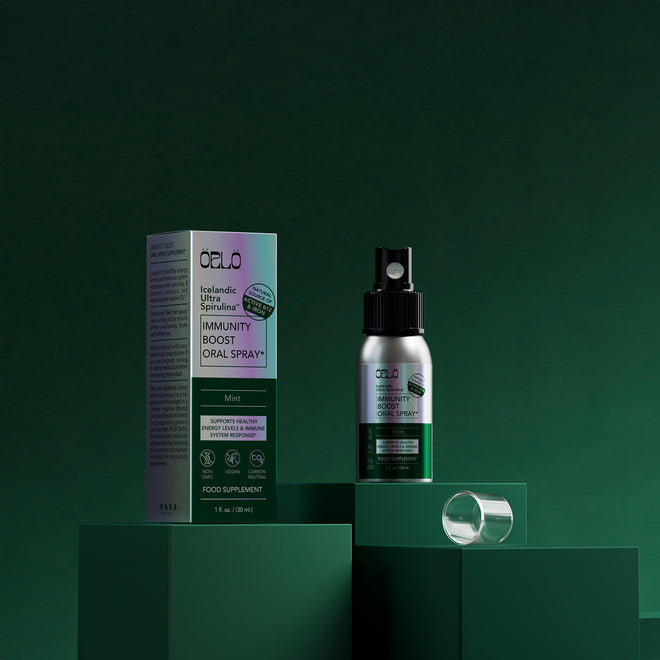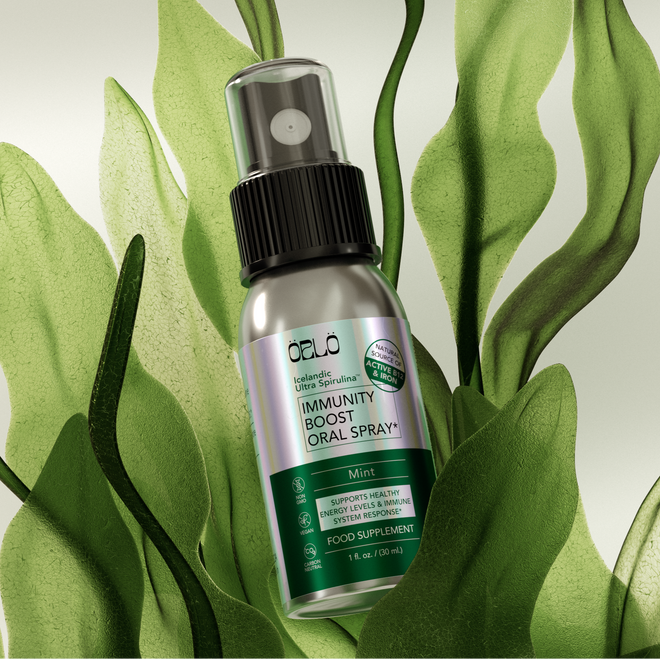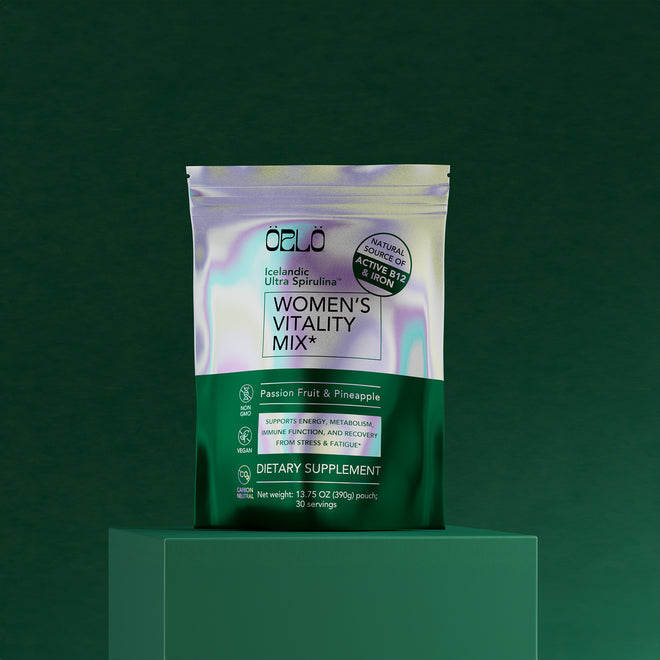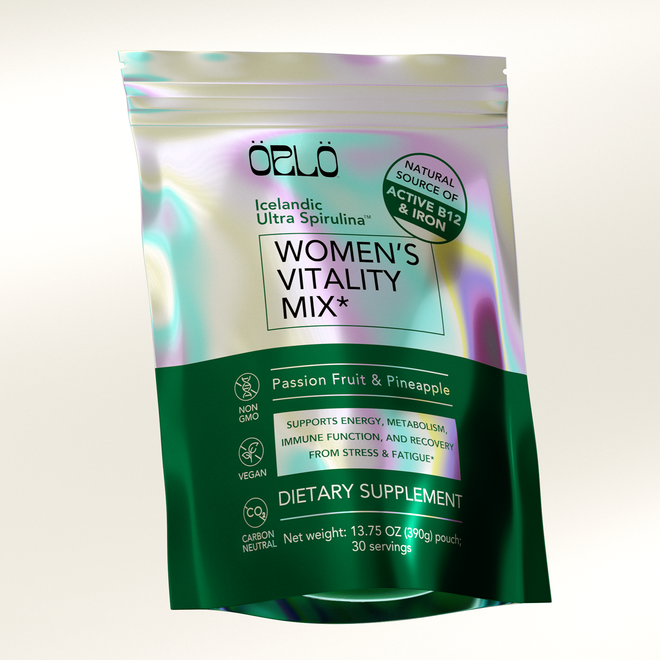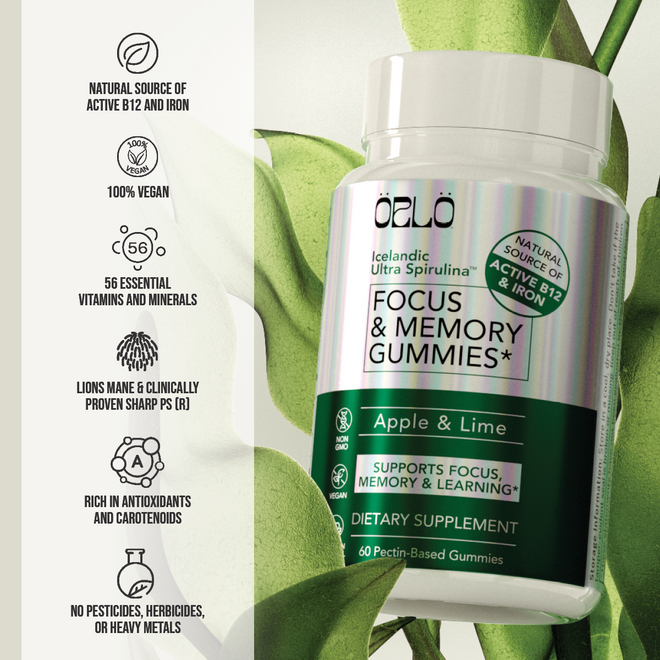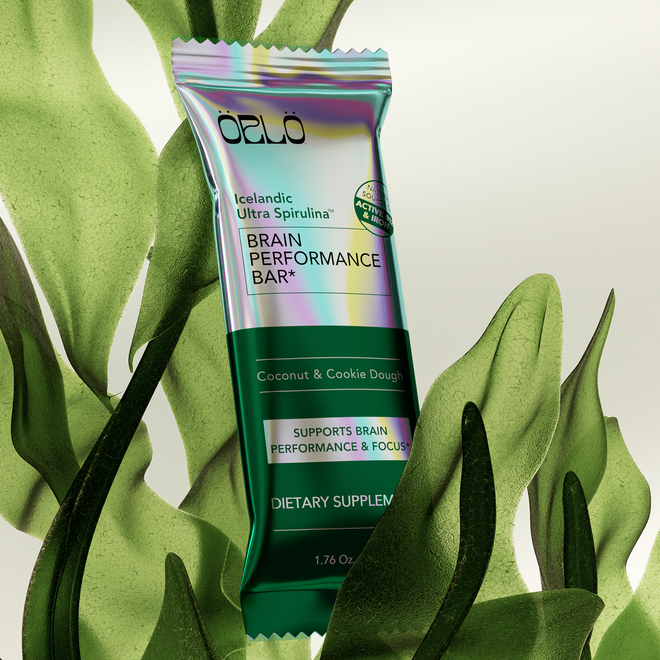25% Off - use code: HOLIDAYS
The Power Of Algae To Nourish Our Bodies And Regenerate Earth With Dr. William Moomaw
Watch the episode here
Listen to the episode here
Oceans are getting warmer and more acidic because of all the carbon dioxide from the atmosphere. This is happening because of deforestation or coal-burning, and it's not helping the ecosystem regenerate at all. This creates a chain reaction where the ocean eliminates algae and fish. The climate problem will never be solved if people keep abusing the natural world. Join Corinna Bellizzi and Dr. William Moomaw as they talk about the long-lasting effects of climate change. Dr. Moomaw is an Emeritus Professor of International Environmental Policy and the Founding Director of the Center for International Environment and Resource Policy at The Fletcher School at Tufts University. He is also the co-author of the Cut Out the Middle Fish paper, which talks about using algae as a protein source. Discover what proforestation means and why people need to build on existing forests. Listen in today to help stop climate change.
---
The Power Of Algae To Nourish Our Bodies And Regenerate Earth With Dr. William Moomaw
Thanks for joining me for another great discussion around nutrition and health without compromise. In this episode, we are going to talk about the intersection of environmental concerns, your health and nutrition, as we get to know William Moomaw. He is the Emeritus Professor of International Environmental Policy and Founding Director of the Center for International Environment & Resource Policy at The Fletcher School of Tufts University.
An MIT school PhD in Physical Chemistry, he has been instrumental in pushing for positive change through his work as a Science Fellow in the US Senate, where he worked on legislation that successfully addressed ozone depletion. He began working on climate change in 1988 as the first director of the Climate Program at the World Resources Institute in Washington.
He has been the lead author of five Intergovernmental Panel on Climate Change reports, IPCC. That was the one that shared the Nobel Peace Prize for its climate work in 2007. He is working on natural solutions to climate change with a focus on increasing carbon dioxide removal and sequestration by forests, wetlands and soils to complement emission reductions from land-use changes and replacing fossil fuels with zero-carbon renewable energy. He even coined the term proforestation, which we'll get to talk about. Dr. Moomaw, welcome to the show.
Thank you, Corinna. That was quite an introduction. Thank you very much.
I'm thrilled to have the opportunity to meet you. As it stands, the work that you've done specifically with the IPCC to put forward international change is incredible. I imagine that you got a chance to know also Al Gore who produced An Inconvenient Truth and shocked much of America and to think differently about climate change.
I met him when he was a Senator before he was Vice-President. In 1988 in Washington, he invited a group of climate scientists and me, as the new director of the World Resources Institute Program, to meet with him for these intense meetings that went on for hours in an unheated Senate office building. He was worried about the energy crisis and all that thing. When Senate wasn't in session, they didn't turn the heat on. Global warming was all outside, but it wasn't in that building. I can tell you that he was a great student. He listened carefully and wrote a pretty accurate book.
He even produced it as a movie so we could capture the imaginations of people to help them understand what was happening. In an article that you co-authored Catalyzing Innovation, Cutting Out the Middle Fish: Marine Microalgae as the Next Sustainable Omega-3 Fatty Acids and Protein Source, you spell out how looking to algae as a novel nutrition source could create more oxygen and sequester carbon while ensuring our marine ecosystem’s rebound, all while feeding humans and animals.
That article was published back in October of 2017. By my estimation, things have only gotten worse as far as the environment is concerned. We have also seen quite a bit of progress in the world of nutrition as it relates to science and research on what we can do with algae. I wondered if you could briefly summarize for our audience how algae are capable of doing all of these things.
All plants have this miraculous capacity to use water and carbon dioxide from the air and a few nutrients from either water or soils in the presence of sunshine to make sugars and then starches. In the case of woody plants, it’s cellulose. One of the amazing things about algae is they don't need that last step. They never have to make wood. They have to make the cellular material that keeps them going. The characteristic of life is that it keeps on living. The individuals may disappear but the species does not.
Algae has an amazing capacity to double its weight in a matter of days, which is faster than any other plant on the planet. They are green. That means they have chlorophyll. They can do this magic and it takes chlorophyll to do it. When I first met Isaac Berzin, he had done some research and he was looking at it as, "Could we use this as a renewable fuel, diesel fuel or something?"
Isaac was a very bright guy but it turns out it was a bad idea because the oils in these materials are very rich omega-3 fatty acids. Fuels should be burning. He had backed out of that long ago and he came up with this idea, “Can we use these for food and for feed to feed fish and livestock maybe.” They also have to make a certain amount of carbohydrates which animals and humans need for energy system.
One day I asked him, I said, “What do you know about the proteins in these algae? What is known about that?” He said, “Not much.” I said, “It's going to be interesting to know how many are essential amino acids.” Human beings need about twenty essential amino acids that we can't make ourselves. It turns out when it was tested that the best food we have that has the balance for us is chicken eggs. This was comparable to amino acids. It was a miraculous discovery.
The characteristic of life is that it keeps on living. The individuals may disappear, but the species do not.
Suddenly, you've had not just curiosity. The title of our paper, Cutting Out the Middle Fish, was referenced the fact that when you farm fish, you go out in the ocean and you drag all the small fish to the bottom of the food chain and feed it to the fish that are on the farm. That depletes the whole ecological functioning of the ocean.
When Isaac called me once he said, “Where do you get your omega-3s?” I said, “From fish like everybody else.” He said, "Where did the fish get it from?" "They get it from algae." That's what got us started on this whole thing. If you follow that trend, you begin to see all kinds of possibilities for different species of algae having different mixes of nutrients that would be very suitable for different diets of us and some of our animals.
As somebody who has worked in this natural products industry for many years, I work to build omega-3 companies, the namesake of Nordic Naturals for nine years. During that entire time, we never talked about where the fish got their omega-3s. We did talk about simple things like what we were seeing was that they were seeing a shift in the percentages of DHA and EPA present in the bodies of the fish. What it would turn out to be the result of was simply that there are different species of algae that are flourishing in our oceans now than there were prior, and they have different levels of EPA and DHA in them. It's going to affect and change the world of fish oil and fish value like what is nutrient-wise within them over the course of many years.
With increasing temperatures in our oceans, different species of algae are flourishing in the ocean. That's creating some more challenges for the fish because they tend to flourish in cooler waters where they are more nutrient-dense. Suddenly, we are in this cyclic collapse or this system that's not sustainable that we can sit here and say, “We only use sustainably-sourced fish to make our fish oil or fishmeal products to feed our animals as we are growing food for human nutrition.”
The reality is it's not proving to be the case because the oceans continue to warm, a little bit by a little bit. The species that can flourish therefore are changing, and we have an ecosystem where the integrity of it is ultimately in collapse. Finding these new novel ways to both address human nutrition, reduce our impact on vital ecosystems, and ensure that we are able to sequester more carbon is all going to be helpful.
We want to have less than a 2-degree increase over the course of the next several years, but it's not looking good. I would love for you to offer your perspective specifically on the latest IPCC report. Where's the silver lining too? How can we find optimism in this so that we can take power into our hands to create positive change for our climate and our health?
The oceans are warming and that means we are eliminating some of these algae just as we are eliminating coral reefs, which means we are eliminating the most biodiverse and rich parts of the ocean. There are some species that have little shells where the ocean has become so acidic from the absorption of carbon dioxide from the atmosphere that they can't build full shells and therefore, their reproductive capacity is becoming more limited.
We can see a direct link between exactly what we are emitting. We don't have to worry about even the warming part. It’s the direct link between what we emit and what goes in the ocean. It makes it more acidic and then many species are affected. Some cultured mussels, clams or something like that were not reproducing very well. There was no viability.

They took the seawater and did it in controlled conditions and neutralized it chemically so it wasn't so acidic. Lo and behold, those same shellfish were able to reproduce just fine. It was a very clear demonstration of what the problem was. We eat very high on the food chain, meaning we are eating meat products. Unfortunately, we don't eat a lot of carnivores. We do eat salmon and some fish that are carnivores. At least, in the West, we do not eat tiger meat or carnivores, but we do eat pork, lamb and other grazing animals.
It's a fairly inefficient process for growing grass. The energy that comes from the sun grows grass to the amount of energy content of the meat that we eat. It takes a lot of water, land and energy inputs to produce a pound of hamburger. Agriculture is behind only in industry and transportation, and not that far behind in terms of its climate emissions. We needed to learn to do agriculture differently.
The more of the intermediate steps we can cut out, and we have those most intensely in the ocean because there are the phytoplankton which are the algae and other small plant-like things. We have the phyto-organisms and the little fish that eat microorganisms. Those get eaten by bigger fish and so forth. The loss every time in terms of food value is roughly 90%. It could be 95% or 85%, but 90% is where it is.
That's the energy and protein content that’s lost every step of the way. That's not very efficient and we are somewhat reluctant to eat further down on the food chain of fish that are vegetarians as opposed to fish that eat fish. We need to rethink that. We also need to have foods that are nutritious and which people like. Because of our history of eating, it better tastes similar to what we eat. It should feel on our tongue similar to the way of things that we are used to eating. That's a tall order to get all that to work and there are a number of non-meats out there.
Tofus and tempehs, most of them are soy-based, but some are coming from other things now too.
Soy uses vastly much more land and water than algae for the same food value content.
It’s back to that exponential growth pattern. In a matter of days, you have doubled the amount of algae you started with. You can recycle the same water and use it over and over, depending on how you are growing it. If you are growing indoors, you could be using renewable energy to create that algae. If you are growing it, you are using the sun and resources but then you are still subject to seasonality and some other challenges.
There are so many different methods of being able to cultivate algae. There are some that are even using fermentation and feeding sugars. Some of them are more energy-intensive than others and ultimately get to the sweet spot of helping the algae to reach its exponential growth pattern, be able to extract it, and be using minimal energy to do so, while also ensuring the carbon you feed it so it can grow isn't escaping into the atmosphere. All of these things need to be done.
Every year, the increase in carbon dioxide in the atmosphere is around half of what people put in.
There's a science behind it, but there's also the rudimentary reality of how photosynthesis works. If we can harness the power of algae and get a protein out of it that maybe one day we'll have the same texture and also the omegas, which we have already become experts at extracting, and other phytonutrients, then we can create something that is way further down on the food chain, but then also less likely to be full of pollutants. It’s less likely to have issues in growing it. You are not having that 90% loss every time that food becomes food that we eventually eat. You are going to the first plant that ever existed, the microalgae.
That means its many uses require the least amount of input energy from whatever sources it takes to grow it, process it and everything else. It means that it's going to avoid many problems like fishing all the little fish out of the ocean to feed the fish that are on the farm. That's being done now and it's proving quite successful. Imagine that. If we get beyond the fish liking it and turning it into a product that we would like, I haven't seen a decent algae burger yet. I don’t think anybody is trying to make one, but someday there will be an algae burger in the sense that algae will be the protein source and it will come with additional nutrients.
In fact, it probably comes with more omega-3s than we need so that could be extracted as a separate product as we are doing now. You can go pay all that money you pay at the pharmacy to get a little tiny bottle of omega-3 oil. You can see multiple ways in which this is going to work. Algae also have other qualities. We were talking about dyes. There are components in algae, which have surprising colors to them that you can't see because you see the green of the chlorophyll, but you don't see these other dyes that are hidden there, or substances in there that could be converted to substances that would be bright dyes or have other important properties. If people say we have struck a gold mine, in a gold mine, you only get gold.
It sounds like you are a big fan of algae. I am too and the more I learn about it, the more deeply entrenched I become in seeing it as a solution plant. One of the things I found surprising when I first learned it is that so much of the oil that we are pumping out of the ground was once algae because it was the thing that lived before anything else. As it was underground and decomposing, it became oil. Some of what we are pumping out of the ground to burn as fuel is essentially algae.
If the plant that started it all, that started life essentially can be harnessed to also be part of the solution, it speaks to the beauty of nature. We have all the resources we need if we can learn to be a little bit more meager in how we extract from the environment. Otherwise, we will have problems in ecosystem integrity, which we'll see in my generation for sure and in my children's too.
We always thought of climate change. It was always talked about as a future problem. We have raised the global average temperature by a little over 1 degree Celsius or that's 1.8 degrees Fahrenheit. We want to keep it below 2 degrees. I would like to keep it below 1.5 degrees which is 2.7 degrees Fahrenheit. We are already at 2 degrees Fahrenheit. We are probably not going to meet that. Look at the problems that we are having now. When I first got into climate change, the idea was, “It is gradual warming and then that means that things will move around and so on.”
What was totally unanticipated was how very simple we even do it at the time. The Earth has not warmed uniformly. At the time, we knew that the Arctic was warming faster than the rest of the world. It’s now warming three and a half times faster than the average for the world. What that has done is it has changed the dynamics of the atmosphere.
We had this stunning thing where the temperature at the South Pole spiked 70 degrees Fahrenheit hotter than it has ever been. Also, the Arctic spiked 50 degrees Fahrenheit warmer than it has ever been. What that means is that massive cold air that used to be stably around the poles is no longer stably there. The winds that kept it in have become weaker. That's how you can have this situation. What that means is a lot of that cold air spilled out of the Arctic. Massive cold air and warm air rushed in because cold air is denser than warm air. It goes down along the ground and the warm air is up above and it goes in and you get these stunning changes.

I see the power of that to fuel some incredible storms. If you are talking about the rapidity of change of temperature like that, you are also talking about the storm of the century type of events.
We are having 100-year storms and precipitation events. The intensity of rainfall or snow is getting more frequent. The 100-year event became the 50-year event. We are down in the 20s for sure and occasionally, we have 1 in 1,000 years. I remember back in the 1990s, the mayor of Newton had just been elected. He was quite big on climate change being a thing. He said, “We had the flood of the century in 1998.” We thought that won't happen for another 100 years. We had another one, three years later. It’s the flood of the century but it was a different century by then. You are saying in a joking way the absurdity of that kind of thinking. He said, “If it's happening this frequently, we better get working on it.”
Let's think about solutions. We have talked a bit about algae. We also talked about the fact that, if you are consuming algae instead of fish, you are not taking from that ecosystem. You are potentially allowing it to recover a bit. We did some calculations based on Orlo’s first line of products, the omega-3 and the prenatal-DHA. We found that for the equivalent level of omega nutrition in one of these bottles, it's 110 pelagic fish not taken from the ocean.
That statistic alone is something that people can get behind. Even if they are not vegetarian or vegan, even if they are a fish oil consumer, this is a change in a positive direction. We may not have yet harnessed the full potential of algae for protein, but it's coming. That's something that I see happening in the next couple of years. We can get to a space where instead of having a soy burger, the impossible burgers of the world, we could have something that's algae-based.
That is harnessing that other part of this plant that can grow exponential growth in a matter of days that can sequester carbon and provide us with oxygen. I wonder if there are other things on the horizon that also give you hope. Whether it be from the proforestation movement or from also the regenerative agriculture that's underway, where we are seeing a shift in these more traditional approaches by farmers across America.
I spent most of my twenty years on the IPCC working on technological solutions. Towards the end of that time, I began to realize something. I knew this way back when I first learned about climate change. Remarkably enough, we thought that the increase every year in carbon dioxide in the atmosphere was around half of what we put in.
If we are putting in roughly ten billion tons of carbon dioxide, the increase is only about five. It's a little better than that, but where is that going? It's going in two places. It's going into the oceans. It’s dissolving in the oceans making it more acidic and it's being taken up by growing plants. That is mostly forests. The IPCC wrote in their report in 2021 that they estimate about 25% of the quarter of what we emit was taken up by the oceans, and 31% or almost a third is taken up by plants on land. The forest is the largest part of that. Estimates are that's probably about 25% as well.
However, we are doing everything we can to degrade the oceans by what we dump into them and the way we treat them. We are degrading our forests, our grasslands and our agricultural soils. If you plant a crop this year, you cannot grow the same amount of crop next year without adding the lost nutrients. At the same time, we have soil that has less carbon content. It holds water less well. We have to add more water, it takes more energy and the energy is provided by fossil fuels.
People want renewable energy so they burn wood instead of coal, but burning wood emits more carbon dioxide than coal.
We are in a vicious cycle of making things worse every year and it doesn't have to be that way. The same is true with forests. People say, "Our forests are being sustainably managed because we are still in a situation where we are not cutting more than the forest are taking out. That's a pretty little bar. That would be meaning something quite extraordinary if we were that close. Canada got not only that close, they exceeded that bar in 2019 when their managed forest went from removing 160 million tons of carbon dioxide a year to emitting 24 tons of carbon dioxide a year.
It's rampant cutting. A lot of it is people saying, “We want renewable energy so we will burn wood instead of coal.” Burning wood emits more carbon dioxide than coal when you get the same amount of energy, and even more so when you turn it into electricity because a wood-burning electric power plant is not as efficient as a coal-burning power plant.
We see things like the Forest Services battling with what the Fire Services want to do. They say things like, “We need to thin the forest because it's a fire hazard in California, Oregon or Washington.” When they are using the terminology of thinning the forest, it really isn't thinning. It's not like they come in with a helicopter and take one tree from the center.
They are cutting swaths of land and creating more bare earth. It takes a long time for the trees to recover from that. It takes a long time for a full-grown forest to recover when you are in this grassland shrub perspective for a while before you get enough canopy above it to do things like creating rain because trees create rain. It's such an interesting cyclical problem that we seem to be making worse, even with the power of intention towards making something better like trying to reduce the likelihood of a forest fire.
When they do the thinning, they mostly take out big trees. When I was a Boy Scout, I learned it was hard to start a fire with a big log and a match. I can start a big fire with a match and a bunch of little kindling and little twigs but I couldn't do it with the big trees or wood. The younger we keep the forest, the more vulnerable they are to fires.
In the United States, we are in a situation where the Forest Service estimates that there is less than 7% of our forests that are more than 100 years old. These are forests that when we got here were 10,000 years old and they had accumulated a lot of carbon. There were a lot of big trees. There is a study in 2018 by Jim Lutz at Utah State University. They studied 48 forests around the world of the mature multi-age forest. Half the carbon was in the largest 1% of big diameter trees.
They may be big this way or not, but it's this way that's important because that little shell that's added every year of carbon going around a bigger and bigger trunk is a lot of carbon. We are immediately losing all that. The biggest source of emissions from forestry is harvesting. It's about 85% of the emissions that occur. It counts fires, insects, diseases, wind and everything. We are not letting enough of our forests grow to be older and bigger forests with bigger trees. There was a lot of research that was showing this. My contribution was working with an ecologist and another colleague. We realized that we should let more trees grow to be big.
This doesn't mean we have to stop cutting all the trees down because there are wood products that are valuable and so forth. We have basically taken the situation that every piece of land that can be a forest for timber should be harvested for timber. That's 70% of the forest lands in the United States. They are called timberlands by the US Forest Service. The only reason it's not more than that is because roughly, half of the remainder or about 15% are little scruffy forests that wouldn't be good for anything and the other half are protected, National Parks and places like that.

That’s pathetic because one of the interesting statements that the IPCC made is they said that in order to have the resilience and the functionality of forests or what they call ecosystem integrity, they estimate that on a global scale, we must conserve approximately 30% to 50% of Earth's land, fresh water and ocean areas including near-natural ecosystems. That recommendation is with high confidence. That's the first time the Intergovernmental Panel on Climate Change which is a group of hundreds of scientists reading tens of thousands of research articles has made a conclusion like that.
We basically set aside 30% to 50% of our land.
Yeah, but we have to be careful which ones we do because left to the special interests, it will be the wastelands, the tops of mountains that have very few things growing on them, and parts of the ocean where there are not any fish. There are huge swaths of the central oceans which have very few fish in them. This has to be done carefully. It's not just 30% to 50% of anything and everything. It’s 30% to 50% that amounts to something in terms of ecological function.
I learned about a new end-of-life service that is interesting and that's this company called Better Place Forests. What they are doing is essentially providing a system where you can choose a forest to dedicate a tree and it's in swaths of land that they are controlling as preserves. They are essentially nature preserves. They are sequestering a lot of carbon because these are old-growth forests or somewhat mid-growth forests but they’re trying to work to preserve large chunks of land.
They become an older forest. Some of those old trees will die someday. There need to be young ones coming along to replace them.
It’s a novel concept. They hired one of the senior executives from Patagonia to be in the CEO seat. They have had some interesting capital infusion and now, it's a service that you could offer. Let’s say that you want to be a tree at the end of your life, they will take the ashes from your cremation and mingle them with some soil to put at the base of a tree.
I love that people are thinking forward about how we can all be a part of the change and create a more cradle to grave or cradle to cradle perspective with how we look at our lives, the products that we consume and also where we are getting our nutrition and how we are preserving the forests. I think that work is incredible. I'm also reminded of a conversation I had with Paul Hawken on another show that I host called Care More Be Better.
When he said, "Swaths of land don't want to be bare. Earth doesn't want to be bare. Often the weeds that you see infiltrating are a sign of nutrients that are missing from the soil. They will come in and help to reinvigorate this land so that a forest can grow." In my understanding, part of proforestation is also setting aside chunks of land that could again become a forest, which is a process that has to be managed. I wonder if you could speak to that.
You can plant a tree, but you can't plant a forest.
I was curious because all these reports talked about what we could do. We can all do solar panels, this, that and the other thing. There was always this little tiny bit that says, “Afforestation,” meaning we'll plant new trees and everybody loves to plant new trees. It's a good thing to do. Another little piece that said to reforest areas that have been deforested. Why are those so small? The reason they are so small is it takes a long time for a tree to get big. It's always set as either by 2050 or 2100. Planting new trees at any time is not going to do much by 2050.
That's a lot of the carbon credits that people are buying.
They are assuming that it's a full-grown tree now when it's not going to be that for 100 years or more. That's to say that’s an iffy way to do the crediting.
It’s a way in which we continue to borrow from the future. We are saying, “In 50 years, it will be sequestering some carbon so I can spend this carbon now.”
We do not have 50 years to get there. The idea of proforestation was since it's the growing trees and the existing older trees, which are still growing if not taller. They are like people. As we get older, we stop growing taller but we may grow wider. Furthermore, in an older forest on every acre, more than half the carbon will be in the soil because year after year, the leaves drop. It decays and a good portion of that material becomes soil carbon. It's nature's version of composting and we all know that if we put our wastes and our leaves into a composter, stir it every once in a while and let the sun hit it. After a while, you have this beautiful rich carbon soil. It’s black earth.
That's what forests are doing by themselves, 7 days a week, 365 days a year. They are building carbon both in the trees and in the soils. The variety of proforestation was that we should recognize that and count the continuing growth as part of the solution because the sustainable forest approach is we'll keep cutting trees and letting them grow back.
Even if that works, you are no better off than you were when you cut them. You are cutting a 50-year-old tree. It takes 50 years to grow it back. If you let it keep growing, you would have more than twice as much carbon in the trees in 50 years, the grow-back period, as if you'd gotten back to where you started. That thinking said to me, “The problem is it takes a whole paragraph to explain this and we need a word for it.”
I started looking at Greek and Latin prefixes on the internet. Meta didn't seem quite right and proto didn't seem quite right. All of a sudden, pro popped up. Forestation means to grow a forest. Proforestation means you are growing forest. Afforestation means you are planting new ones. Reforestation means you are replacing old ones, but there was no word for continually growing existing forests.

It works well for two reasons. One, there are no emissions associated with harvesting. Secondly, it is accumulating for many decades or sometimes centuries. It has caught on and I'm astounded at the number of people that have read that paper and the number of references it's getting. Not all are favorable because needless to say, the forestry industry doesn’t favor that idea very much.
That’s sad. The reason that they are in existence is that there are forests yet they are not pro-forest. There's this concept of our forest as a farm or as a place to get food, to even think about doing things like planting and harvesting trees on the perimeter of some forests. I wonder what your thoughts are around the potential for our forest to become a food source for at least communities around those forests.
I'm not sure. The fruit and nut trees have to be planted next to them. I do know that in Costa Rica, even when they have banana plantations, if there are bits of forest around it, the productivity goes up. The reason is pollinators. Pollinators are everything from bats to insects to birds. The farmers who leave these pieces of the forest as part of their banana plantations get payments for ecosystem services. In other words, the service, in this case, is pollination. That's one way you could do it and it comes as close to what you are talking about or a real example that I know about.
I also know in large chunks of Italy, there are chestnuts everywhere. We don't have that anymore in the United States because there was a blight that killed off much of the chestnut forests that we had. It doesn't mean that we can't also turn to some food-bearing trees as part of this proforestation effort or even afforestation effort.
It was important for many animals in the forest, and the animals are important for dispersing the seeds. It's not as though a forest is just a bunch of trees. Here's another little catchy phrase I like, “You can plant a tree, but you can't plant a forest,” because a forest is a complex ecosystem that includes microorganisms in the soil and the park and fungi.
The fungal networks, which we have only learned in the fast last few decades are essential to bringing nutrients to trees. If there's a fungus, get rid of it. Get a fungicide out there. We had this idea that it was like a corn patch where you don't want any weeds in there. In the forest, all these other species of plants are not weeds in a natural forest.
A friend of mine in Australia pointed out to me that the fact that 80% of biological diversity on land is in forests is the wrong way to think about it. A forest is itself a highly ecologically functioning ecosystem. It would not be a forest or we should probably not call it a forest unless it has this wide range of biodiversity from soil organisms doing all the creepy crawly things. There is all this stuff we don't even think about. We think about furry creatures. There's a beautiful tree but it’s so much more than that.
In my home, we have compost. We compost our organic matter. I have an undeveloped portion of my land that is also a forest. We tend it by keeping the base saplings at a minimum because they tend to be fire letters, but we have preserved some very large oak trees and working to keep that healthy space. These are all things that we are working to do in our space. We didn't develop this portion of our land because it is a forest.
We will not solve the climate problem if we keep abusing the natural world.
Since reading Paul Hawken’s Regeneration and learning more about how regenerative agriculture works, I have stopped looking at weeds the same way. I’m thinking about it as if I can cut it without tearing all the root system out, I'm doing my own little part of helping to preserve the carbon that's in the soil and the ecosystem that is that soil. The earthworms and everything else. The microbes that are essentially helping me create the strawberries, mint, oregano and the fruit trees that I have too. It's a great thing to educate ourselves because if we have a little patch of earth that we can manage, then perhaps we can be more part of that solution.
When you think about the fact that the area of yard lawns in the United States is greater than the area of the state of Pennsylvania and these are our ecological deserts. Everybody works and works to make sure there are only one species of bluegrass on that lawn. They spend a lot of money, chemicals and all these things to keep it that way.
It would be far more interesting and productive if they didn't insist on having that kind of a yard. We even do it in places. I lived in Los Angeles for a while. I was astounded. They had Minneapolis-style lawns and it was watered all the time. The Colorado River is running out of water and that supplies a big portion of Southern California's water system. It’s thinking differently. They had a spectacular bunch of desert species in California. They are great ornamental for your space.
You're preaching to the choir. My father is a landscape architect here he specializes in using local plants in these projects because they require a lot less water. They tend to get established rather quickly. They are beautiful and a lot of his projects include zero lawn. It's a huge cost environmentally. Also, if you think about how much we are now paying for water in California, those rates keep going up and there's a good reason for it.
They are trying to control our behavior through our pocketbooks, which is probably a little bit easier to do than by telling us about all the ecological reasons we need to be concerned about. I have enjoyed this conversation, Dr. Moomaw. I appreciate all of your work. I would love to offer you the floor if you have a closing thought or if you had a question that you wish I asked that I hadn't. Please ask for an answer.
My plea would be that we'd be more thoughtful about everything we do. I have gone through the whole technological piece. I live in a zero-net energy home in cold New England. It is the first one engineered to be that. It’s energy from solar panels. The heat from the ground stored summer heat that I have used in the winter. I cool with natural systems and so forth. I have had an electric vehicle now for three and a half years and three-quarters of the miles I drive on it are done for my solar panels. High gasoline prices do not bother me at all and the sun will be shining certainly through the rest of my lifetime. I have got a pretty good system here, but it's also critical.
We will not solve the climate problem if we keep abusing the natural world. I was so impressed that the IPCC report that deals with the impacts, vulnerability and adaptation had a phrase that is so powerful. It says, “Safeguarding biodiversity and ecosystems is fundamental to climate-resilient development.” That's us developing our lives and things. It's fundamental to climate-resilient development in light of the threats climate change poses to these ecosystems and their roles in adaptation and mitigation.
In other words, having forests intact do more to make us more resilient and to adapt as well as mitigating by removing so much carbon. They make that statement with very high confidence. They go on to say, “Building resilience of biodiversity and supporting ecosystem integrity can maintain benefits for people including livelihoods, human health and well-being, the provision of food, fiber and water, as well as contributing to disaster risk reduction and climate change adaptation and mitigation.” That is so good. Where do I sign up?
It's going to take all of us working towards a solution like this for a generation and possibly more in order to safeguard our future. I appreciate the work that you've put out there. Thank you for your time, Dr. Bill Moomaw. Thank you for joining us.
Thank you very much for having me. I appreciate the opportunity.
---
I hope that you've learned a thing or two. Perhaps you've even made a decision to try and do things a little bit differently in your life. Whether it be replacing some of the food that you are eating with something that's more plant-based or even considering taking algae supplements over fish oil. We have many products available. Orlo Nutrition already offers a couple of omega-3 products, as well as a spirulina extract to support your immune system. You can find out more at OrloNutrition.com. Thank you for joining me on the show. Here's to your health.
Important Links
- Center for International Environment & Resource Policy
- Climate Program
- Intergovernmental Panel on Climate Change
- An Inconvenient Truth
- Cutting Out the Middle Fish: Marine Microalgae as the Next Sustainable Omega-3 Fatty Acids and Protein Source
- Nordic Naturals
- Better Place Forests
- Patagonia
- Paul Hawken – previous episode on Care More Be Better podcast
- Regeneration
- IPCC report - Climate Change 2022: Impacts, Adaptation and Vulnerability
- OrloNutrition.com
- https://www.LinkedIn.com/in/william-moomaw-09a8525/
- https://Fletcher.Tufts.edu/people/william-moomaw
About Dr. William Moomaw
 Dr. William Moomaw is Emeritus Professor of international environmental policy and founding director of the Center for International Environment and Resource Policy at The Fletcher School at Tufts University. An MIT schooled PhD in Physical chemistry, he has been instrumental in pushing for positive change through his work as a science fellow in the U.S. Senate, where he worked on legislation that successfully addressed ozone depletion.
Dr. William Moomaw is Emeritus Professor of international environmental policy and founding director of the Center for International Environment and Resource Policy at The Fletcher School at Tufts University. An MIT schooled PhD in Physical chemistry, he has been instrumental in pushing for positive change through his work as a science fellow in the U.S. Senate, where he worked on legislation that successfully addressed ozone depletion.
He began working on climate change in 1988 as the first director of the climate program at World Resources Institute in Washington. He has been the lead author of 5 Intergovernmental Panel on Climate Change (IPCC) Reports. The IPCC shared the Nobel Peace Prize for its climate work in 2007.
He is currently working on natural solutions to climate change with a focus on increasing carbon dioxide removal and sequestration by forests, wetlands and soils to compliment emission reductions from land use changes and replacing fossil fuels with zero carbon renewable energy. A lifelong environmentalist and eco-warrior, he even coined the term "proforestation".
